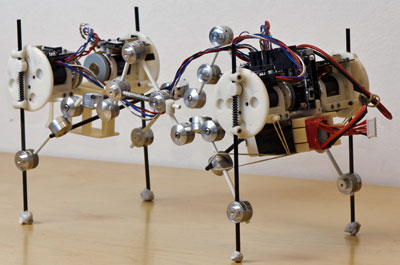
It only Takes Four Hours to Build a Walking Robot
Researchers from the Faculty of Engineering have developed a kit that allows you to build a walking robot in a few hours. It may be significant for the development of walking robots.
It now only takes four hours to build a robot that can walk or even run. Normally, it takes trained robot engineers months to build a walking robot, but an innovative robot kit, LocoKit, makes it possible to build walking robots in a few hours. It can give impetus to the development of walking robots.
- It is a construction kit like Lego. But Lego is mostly geared towards rigid structures such as houses and cars. If you are building something that can walk or run, it quickly becomes a bit stiff and heavy, explains PhD Jørgen Christian Larsen from the Maersk Mc-Kinney Moller Institute, who has helped develop LocoKit.
The only limit is your imagination
If you want to build a robot that can run it is possible to achieve a top speed of approximately 1 meter per second, corresponding to 3,6 km/h for a robot the size of a cat. In the box with all the robot parts there is a construction manual, which helps the user to build a four-legged robot. But it is only your imagination that sets the limits.
- You would probably often choose to build a robot with four legs, but you can easily build one with two, six or eight legs, usually it is just not very practical. It is also possible to imagine building a robot that jumps like a frog, explains Jørgen Christian Larsen.
From wheels to legs
The kit allows the robot researchers to more quickly gain knowledge of walking robots. When the robot is built researchers can explore how the robot keeps its balance and coordinates its movements. In this way, researchers can quickly create great process for walking robots.
- Research on walking robots is rapidly evolving. But if robots are to feel at home in our environment they need legs. Our world is designed for legs. Wheels are just not optimal when the robots have to cross doorsteps or go up and down stairs in our home, says Jørgen Christian Larsen.
Foundation for new robots
The researchers have big plans for walking robots. For example, they imagine that robots in the distant future can be useful as the home carer’s little helper. While the home carer of flesh and blood focuses on human contact, the robot takes care of cleaning and tidying.
- LocoKit does not allow researchers the opportunity to build the world’s most advanced walking robots, but it is a good research base, which quickly gives researchers the answers to details concerning how the robot’s body shape affects its ability to walk, says Jørgen Christian Larsen.
For more information contact
Assistant Professor Jørgen Christian Larsen from The Maersk Mc-Kinney Moller Institute: jcla@mmmi.sdu.dk, phone: 2845 9215